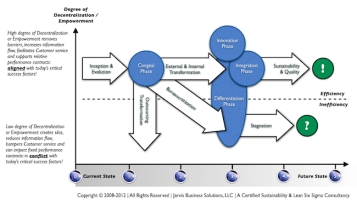“The art of life is a constant readjustment to our surroundings.”
~Kakuzo Okakaura
________________________________
Herb Kelleher is often quoted as saying; “If you don’t change, you die.” When asked by his successor, Gary Kelly, to expand on that notion, he said, “If things change faster outside your company than they change inside your company, then you have something to worry about.”
Change is often called the “business constant”. For change in the marketplace, the government, regulations, Customer needs and wants, various forms of technology, even the issues of land, water and air are variables that influence business and your enterprise. So, I agree whole heartedly with Mr. Kelleher and Mr. Kelly.
The beliefs of Mr. Kelleher and Mr. Kelly are substantiated by McKinsey & Company research. Their experience with scores of major transformation efforts, combined with research they have undertaken over the past decade, suggests that four key functions collectively define a successful role for the CEO in a enterprise transformation:
- Making the transformation meaningful. People will go to extraordinary lengths for causes they believe in, and a powerful transformation story will create and reinforce their commitment. The ultimate impact of the story depends on the CEO’s willingness to make the transformation personal, to engage others openly, and to spotlight successes as they emerge.
- Role-modeling desired mind-sets and behavior. Successful CEOs typically embark on their own personal transformation journey. Their actions encourage employees to support and practice the new types of behavior.
- Building a strong and committed top team. To harness the transformative power of the top team, CEOs must make tough decisions about who has the ability and motivation to make the journey.
- Relentlessly pursuing impact. There is no substitute for CEOs rolling up their sleeves and getting personally involved when significant financial and symbolic value is at stake[1].
Change is preparing your organization to lead and be proactive ahead of a change curve. Read this article and understand some of the insights gleaned from Southwest airlines are important. http://tinyurl.com/lxoxyqk
_________________
[1] Aiken, Carolyn B. and Keller, Scott P.; The CEO’s role in leading transformation; Insights & Publications; February 2007
______________________________________
Owners, Executive and other Leaders are investigating a global world concerned about Sustainability, that type of understanding can be difficult to obtain. In early December 2013, I published my second book entitled “Building a Bridge to Benefits”. If you are interested in reading about the book or want to purchase copies today, here is the link to CreateSpace, an Amazon company, go to: https://www.createspace.com/4532590
______________________________________
Contact information and Services
A Certified Sustainability and Quality consultancy
• Sustainability and Quality Consulting
• Sustainability and Quality Workshops
• Sustainability and Quality Speaking Engagements
Jarvis Business Solutions, LLC
Toll Free: (888) 743-3128
Email: Ralph.Jarvis@JarvisBusinessSolutions.com
Web site: http://www.JarvisBusinessSolutions.com

